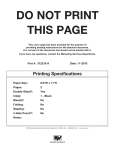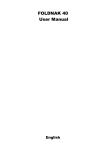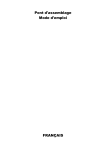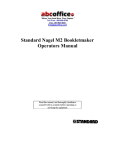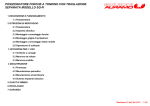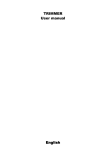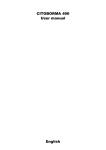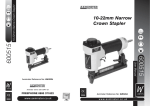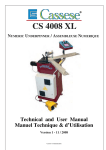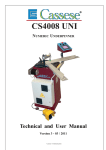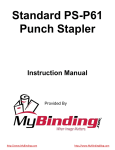Download English FOLDNAK 4 / 6 / 8 User Manual
Transcript
FOLDNAK 4 / 6 / 8 User Manual English 1 Contents 1 Contents 2 Description of function 3 Safety rules 4 Installation 4.1 Slat conveyor 5 Preparation 5.1 Stapler heads / Stapler head distance 5.2 Staples 5.3 Inserting staples 6 Operation 6.1 Control panel 6.2 Magazine control 6.3 Staple error control 6.4 Equipment control 6.5 Stapling brochures 6.5.1 Formats / Number of sheets 6.5.2 Adjustment of the side stop 6.5.3 Adjustment of the rear stop 6.5.4 Adjustment of trigger 6.5.5 Triggering by hand 6.5.6 Counter 6.5.7 Adjustment of the slat conveyor 6.5.8 Stapling 6.6 Stapling blocks 6.6.1 Formats / Number of sheets 6.6.2 Block stapling with the Foldnak 8 6.6.3 Block stapling with Foldnak 6 and Foldnak 4 7 Accessories 7.1 Staples heads, staplers 7.2 Vertical vibrator 7.3 Coupling to assembling machines 7.4 Trimmer 8 Service 8.1 Possible malfunctions 8.2 Change the driver 8.3 Stapler head care and malfunctions 8.4 Cleaning rollers 8.5 Rotating the machine by hand 9 Technical data 10 Conformity statement 2 2 Description of function 1. Control panel with main switch 2. Guard plate • The machine can only be operated with a closed guard plate 3. Slat conveyor 4. Turning handle 5. Opening to decouple the folding knife. 6. Protective cover • The machine can only be operated with a closed protective cover 3 Dear customer, Thank you for having decided upon our stapling folding machine. With the purchase of this quality product you have made a good choice. • Lay out the electricity cable in such a way that it does not form any kinks. • Work place of the operator: in front of the machine. • Only erect the machine in a dry room. Please read these user instructions carefully before using the machine and follow the security rules. 4 Installation The numbers in brackets in the text relate to the figures. • Loosen the restraining straps of the wooden box. • Remove the wooden box. • Strip the packing foil to the bottom. • Loosen the restraining screws between the Foldnak and the palette. • Lift the machine from the palette and place the machine on a solid and level surface. 3 Safety rules • Only carry out repairs with original NAGEL spare parts. • Only carry out repairs after disconnecting from the mains electricity supply. • Repairs and work upon electric appliances may only be carried out by trained tradesmen. • Removal of safety equipment and casing and operation with damage that affects safety is forbidden (e.g. damaged electricity cables, covering). • Use the machine exclusively to staple documents out of paper and cardboard. 4 4.1 Slat conveyor These axle brackets on both sides of the slat conveyor are to be swung into a vertical position and, after loosening the knurled screws, then secured. When not in use, the axle with the transport wheels can be taken off, the axle brackets folded towards the bottom and the slat conveyor can be folded upright and locked in order to save space. The slat conveyor (fig001, 3) (option with Foldnak 4) is folded upright for transport and locked with a hook. Raising the hook unlocks it and swings it into an approximately horizontal position. In this position the rod (11) is guided into the hole of the foot stand as a prop. The rear collecting plate (13) is then hung downwards at an angle. The axle and both wheels (10) are accessories. They must be pre-mounted with the set collars, which are also accessories, so that both wheels are exactly over the green conveyor belts when the axle lays in the long vertical slits of both axle brackets (12). 5 5 Preparation 5.1 Stapler heads / Stapler head distance Foldnak stapling-folding machines are delivered with two stapler heads as standard. They can be operated with up to four stapler heads. The possible stapler head positions are: Type Foldnak 8 Foldnak 6 Foldnak 4 Distances in mm 30 x 50 x 80 x 50 x 30 30 x 50 x 80 x 50 x 30 50 x 80 x 50 The driver (20) is re-set as described in Chap 8.2. By adjusting the stapler heads and simultaneous adjustment of the side stops, the position of the staples in the paper can be altered. Care must be taken that the stapler heads are not placed over the side stops, especially when the stapler heads are used in the outer positions. Finally, plug the contact cable (19) onto the contact bank (18). The stapler heads can be adjusted in the previously given positions. For this, the screws (21) behind the stapler head batten (22) must be unscrewed with the supplied hexagonal spanner, the stapler head must be put into the desired position with the spigots and screwed tightly again. 6 5.2 Staples 5.3 Inserting staples Foldnak stapling-folding machines use the following Nagel-staples: In order to insert staples, first of all the staple slide (26) is to be pulled back with the index finger on the underside of the stapler head magazine until it engages. • 26/6 26 = Wire guage 6 = Shank length in mm for 2 up to ca. 20 sheets • 26/8 S 26 = Wire guage 8 = Shank length in mm S = Steel wire for 15 up to ca. 40 pages • Ri 26/6 Ri = Ring staples 26 = Wire guage 6 = Shank length in mm for 2 up to ca. 20 sheets Only use original Nagel staples. They are made with special precision and therefore guarantee problem free and accurate function. We can only honour the staple head guarantee when Nagel staples are used. Then swing back the magazine cover. Insert the staples in this position. The magazine holds a stick of 210 staples or ring staples. When changing staples, check that no staples of the old type have been left in the magazine. Then the magazine cover is to be closed and the staple slide guided forwarded with the thumb and index finger. Do not let it shoot forward too quickly otherwise the staple stick breaks. 7 6 Operation (30) Block stapling switch. Switches on the block stapling stop in position 1. (29) Rotary button for the slat conveyor. Controls the separation of the brochures on the slat conveyor (see Chap. 6.5.7, only Foldnak 8). 6.1 Control panel Foldnak 6 und Foldnak 4 do not have the switches (30) and (29). 6.2 Magazine control The Foldnak is fitted with a magazine control. When there are not any more staples in the staple magazine, the machine does not trigger. This state is indicated by illumination of the red signal lights (36) on the control panel if the contact cable (fig003, 19) has been fitted. The Foldnak 8 control panel is laid out as follows: (36) Red signal light. It illuminates when the staples are finished or jammed. The machine can not trigger any more. (35) On - off switch. (34) Numbers counter with reset button. (33) Service switch wide. In position 1 it serves as a brake lifting switch for the stroke motor brake. (32) Service switch narrow. It serves as manual release. The photo-cell must be pushed out for this. (31) Folding rollers on - off. The rollers must be switched off for block stapling. 8 6.3 Staple error control 6.5 Stapling brochures The foldnak is equipped with a staple error control. The staple error control stops the machine triggering when there is a staple jam in the stapler head. In this condition the driver jumps out of its suspension and touches the spiral contact (fig003, 15). This causes the red signal light to illuminate. Then the driver has to be hung again after any stapler remnants have been removed from the stapler head (see chap. 8.2 and 8.3). 6.5.1 Formats / Number of sheets Paper formats from 140 x 210 mm to 325 x 450 mm can be processed in the Foldnak stapling folding maching. This includes for instance DIN A3, A4 and A5. The number of sheets which can be processed in a brochure is dependant upon the thickness of the paper and the cover. Dependant upon the paper quality ca. 30 sheets of 70g paper or 25 sheets of 80g paper can be processed for brochures with 120 or 100 pages. When a cardboard cover is used then the number of sheets is to be reduced accordingly. 6.4 Equipment control The Foldnak is equipped with an equipment control. It stops the stroke triggering when the paper has not been laid in correctly. The equipment control only works when the trigger has been correctly adjusted (see chap. 6.5.4). 9 6.5.2 Adjustment of the side stop Then adjust the right stop. First of all adjust the side stop with the assistance of the scale (38) on the green table plate. To do this the knurled screw (39) is opened and the stop moved to the side. To do this, insert a sheet of the paper to be processed and, after opening the knurled screw (41), the right stop is then brought flush to the sheet. From there, move ca. 4 mm to the right and secure the side stop in this position. This guarantees that the jogging movement which has been built into the right side stop, and is ca. 4 mm, lines up the staples smoothly. After correct adjustment the knurled screw is again tightened. 10 6.5.3 Adjustment of the rear stop 6.5.4 Adjustment of trigger Adjustment of the rear stop is carried out by the turning handle (4, fig001) on the left side of the machine (only Foldnak 8). For adjustment a sheet of the paper to be processed is inserted. The turning handle is then moved so that the upper edge of the paper aligns with the format mark (for DIN formats), which correponds to the paper format on the scale on the equipment table. Adjustment is carried out when the machine is switched off. Under the Foldnak work table is an adjustable photocell which has a baffle plate (48) mounted upon it. Adjustment: • Switch off Foldnak. • Insert a sheet of the format to be used. • Loosen screw (49) and push the photocell under the sheet. • Switch on Foldnak. • Pull the photocell slowly back until the Foldnak triggers. Then tighten the screw (49) in this position. With Foldnak 6 and Foldnak 4, open the guard plate (43) and lock it upwards. Then move the rear stops (44) after opening the knurled screw (45). Correct adjustment of the rear stop is to be checked by a trial stapling. 11 6.5.7 Adjustment conveyor The switched-on machine now triggers automatically when the paper has been correctly inserted. of the slat In order to be able to optimally utilise the capacity of the slat conveyor (fig001, 3), brochure movement on the slat conveyor is adjustable (only Foldnak 8). The movement, i.e. overlapping of individual brochures on the slat conveyor, is adjusted by the rotary switch (fig005, 29). The baffle plate has the function of a barrier, it prevents single sheets jumping back. 6.5.5 Triggering by hand Triggering can be carried out by hand when desired. For this, the photocell plug (fig009, 47) must be removed. The stroke is triggered by pressing the switch (fig005, 32) on the switch panel. The distance of the Foldnak suppression wheels is also to be adjusted. For this, adjust the axle brackets (fig002, 12). A rule of thumb is that for small formats the wheels have to be closer to the Foldnak and further away for larger formats. The individual optimal adjustment is to be ascertained for a brochure. 6.5.6 Counter The counter on the switch panel can be re-set to zero by pressing the red switch whenever work is started. The number of brochures produced can be seen on the counter. 12 6.5.8 Stapling 6.6 Stapling blocks After switching on the machine, the paper is laid onto the equipment table. When is is correctly inserted, triggering occurs automatically. Should the paper not be correctly inserted, i.e. the upper edge of a sheet does not cover the photocell, the paper can be smoothly pushed by hand through the wide slit in the middle of the equipment table. This task becomes unnecessary when you use a vertical vibrator (see chap. 7.2). The first stapling should be a trial stapling to check the adjustments. The staples should be located an equal distance from the upper and lower edges of the brochures, sit exactly in the fold, and the fold should be exactly in the middle of the format. If necessary adjust the stops. 6.6.1 Formats / Number of sheets The maximum number of sheets when stapling blocks is approximately as follows according to the paper weight: Paper weight: Foldnak 8 Foldnak 6 Foldnak 4 70g 55 sheets 40 sheets 40 sheets 80g 40 sheets 30 sheets 30 sheets Depending upon how the paper is inserted, stapling can be, for instance, a staple in the upper left corner (corner stapling) or two staples at the side (block stapling). The distance to the edge of the paper is fixed, and is ca. 5 mm. Adjustment of the side stops and triggering is the same as that of brochure stapling (see chap. 6.5.2, 6.5.4). Do not use the format marks on the scale under the work table when adjusting the rear stop. 13 6.6.2 Block Foldnak 8 stapling with the Re 3.) Decouple the folding knife: With the Foldnak 8, blocks can be stapled in the form that the block is automatically laid out on the slat conveyor. Changing to corner or block stapling: 1. Switch off the rollers (switch fig005, 31) 2. Switch on the block staple stop (switch fig005, 30 on position I) 3. Decouple the folding knife 4. Adjust the slat conveyor When the machine is switched off, the folding knife is decoupled by unscrewing screw (52) with the supplied 4 mm hexagonal spanner. The screw must be completely unscrewed and removed. Two holes for keeping the screw and hexagonal spanner are located on the right in the cubby hole of the front plate. Carry out these steps in the reverse order in order to switch off block stapling. IMPORTANT: After again changing to brochure production, the screw (52) must be completely screwed in again. It moves during operation and would otherwise break off. 14 By adjusting the support (57) the slat conveyor is folded at an angle downwards. The collecting plate (55) is folded upwards and retained in this position with both knurled screws (56) to the right and left of the slat conveyor. Re 4.) Adjust the slat conveyor: Both transport wheels are inserted into the upper position of the axle brackets so that they somewhat brake the block that falls out. The jump angle (54) is raised and pushed a little to the right or left, so that it supports itself on the slat conveyor. It prevents the block slipping down into the gap between the slat conveyor and the machine. The strap (60) is then taken off after the screw has been loosened and both of the rear stops (59) are unscrewed so that the block can fall out of the machine after stapling. 15 6.6.3 Block stapling with Foldnak 6 and Foldnak 4 When guiding the stop, push the moving arm up in the direction of the arrow (fig013, 67) and at the same time push the stop in the direction of the arrow (fig013, 66). It then clasps the lower roller. It is important for the correct seating that the stop groove is at the position (fig013, 64) under the rear wall plate. For block stapling the rollers must be switched off by the switch (fig005, 31) on the switch panel. Then pull out the photocell plug (fig009, 47). Triggering is done by hand by using the switch (fig005, 32) on the switch panel. When the stop is fitted, the paper can be inserted in the machine from the front. It knocks against the position (fig013, 63). After stapling, the paper can be removed by hand. The supplied block stapling stop (fig013, 66) (accessory for Foldnak 4) is necessary for block stapling. The additional stop is to be guided into the long slit in the rear wall underneath the rollers. Thereby hold the smooth side of the stop parallel to the rear wall. Fig013 shows the correct position of the stop. 16 7 Accessories 7.1 Stapler heads, staples Foldnak 8, 6 and 4 can also be subsequently connected online (i.e. with mechanical and electronical connections) with all current table assembling machines and many assembling towers: • Nr. 2932600: Additional stapler heads • Nr. 6272060: 5,000 Staples 26/6 • Nr. 6272081: 5,000 Staples 26/8S • Nr. 6274062: 5,000 Ring staples Ri 26/6 Nagel ZN 10, ZN 8 Watkiss Vario / Eco / Slim Vac Plockmatik 310, 306, 410, 406 Duplo DC-10 mini, DC-8 / 6 mini Uchida UC-800 / 1000 Panduro PC-6, PC-8 C.P. Bourg BT12, BST10 Barenthin Horizon or Stielow QC-P8, QC-P10, AC 1200, AC2400A, AC 8000S • AB Dick 10 and 6 station table assembling machines • AM International 10 and 6 station table assembling machines • • • • • • • • • 7.2 Vertical vibrator The vertical vibrator replaces manual jogging during hand feed. The vertical vibrator ensures that the stapled product always lays against the rear stop without any problems. Order no. 285520x (x = according to electrical voltage). In order to save time with trimming the front, Foldnak 8 and 6 are able to be of connected online to the Nagel Trimmer. 17 7.3 Coupling machines to 8 Service assembling Brochures can be produced more 8.1 Possible malfunctions economically efficient with automatic paper feed. This is made possible by • Machine does not function: Electricity coupling the Foldnak to an assembling plug plugged in? Main switch switched machine. on? Safety covers open? Nagel offers two table assembling • Electricity cuts out: Press the circuit machines: ZN 8 and ZN 10 with 8 or 10 breaker in again after a short time. It is stations (only in Germany). These located below the electricity cable exit. models are optimally adjusted for the Foldnak. But even coupling to every other table assembling machine and to 8.2 Change the driver many large assembling towers is possible with Nagel accessories. Your Drivers are subject to wear and tear and Nagel dealer will happily advise you. must be changed occasionally. The driver (fig003, 20) is hung from a spigot (fig003, 16) and is secured with 7.4 Trimmer a knurled screw (fig003, 17). When overloaded, it jumps from the When processing sets from ca. 4 sheets spigot and is pushed up until it touches = 16 pages, the inner sheets are pushed the spiral contact (fig003, 15) and forwards visibly. These inner sheets are thereby activates the staple error control trimmed flush through front trimming (see chap. 6.3). A precondition for this in the Trimmer. Thereby every brochure is that the contact cable (fig003, 19) is receives a professional and clean mounted, which connects the stapling appearance. head with the contact bank. When the The fold becomes less sharp with thick knurled screw (fig003, 17) is loosened layers. The Trimmer therefore the driver can be re-hung onto the additionally presses each brochure spigot. again and thereby improves the quality Afterwards the knurled screw is to be of the fold. re-tightened. 18 To change the driver, loosen the knurled screw and pull the driver from the spigot which is sprung and on bearings, and pull it upwards out of the stapler head guide. To install, guide the driver in from above and hang it on the spigot. Then tighten the knurled screw. When changing the driver, care is to be taken that the engraving “26” on the upper end of the driver shows towards the operator. Normally Foldnak stapling folding machines are delivered with ring drivers (item no. 2932619) which are suitable for stapling with ring staples or staples. Instead of the ring driver, a flat driver (item no. 2932616) can be used for thick layers. 8.3 Stapler head malfunctions care Then replace the stapler head and tighten the knurled screws (24). Staple remnants in the guide channel can lead to driver breakage. Please, therefore, thoroughly clean the guide channel every time stapling is unsuccessful. Very thinly grease the driver above the stapler head after approximately ever 5,000 staplings. Clean the stapler head regularly, otherwise faulty operation could occur because of dirt. Should there not be any staples in the paper although the magazine is full: Check whether the staple slide is bent forward due to accidentally being allowed to spring forward. If this is the case then carefuly file off these burrs so that the staple slide can again push completely forwards into the stapler head. and Damaged staples must be removed from the stapler head staple channel. For this, pull back the staple slide (fig004, 26) until it engages, then loosen both knurled screws (fig004, 24) and swing the straps (fig004, 27) towards the bottom. 8.4 Cleaning rollers With use, printer’s ink can collect on the rollers. This can reduce the rollers’ grip. For this reason the rollers must be cleaned when needed. A cleaning agent can be used for this, such as is used for folding machines or pressure rollers. The stapler head can be pulled off after the contact wire has been pulled off. The stapler head front plate and the magazine are to be cleaned of staple remnants as well as the front plate still in the machine. 19 8.5 Rotating the machine by hand 9 Technical data It can be necessary to rotate the machine by hand for servicing. • Manufacturer: Ernst Nagel GmbH, Breitwiesenstr. 21, D-70565 Stuttgart, Germany • Electricity supply: See type plate on the machine • Series number: See type plate on the machine • Year of manufacture: First two digits of the series number • Noise emission: < 70 db(A) • Pull the photocell cable (fig009, 50) out of the plug socket for this. • Remove the turning handle (fig001, 4) for the rear stop. Remove the side wall plastic top and reinsert the turning handle there. With Foldnak 6 and 4 use the pipe spanner from the accessories bag as a turning handle. • Move the wide service switch (fig005, 33) to position I so that the stroke motor is raised. • Press the narrow service switch (fig005, 32) briefly several times. Now the machine can be rotated clockwise by hand. After completing servicing the photocell cable must be inserted when the machine is switched off, otherwise a stroke is triggered. 20 10 Conformity statement This machine has been checked by the printing and paper technical committee of the employer’s liability insurance association for conformity with the CE European Norm and the requirements for tested security and complies with EC Directives 89/392 and 89/336. Norms used: EN 954-1, prEN 1010, EN 60204. Michael Kipp Manager 21 22 Foldnak 4/6/8 SN:> 980704 02. 1998 23 Ernst Nagel GmbH D – 70565 Stuttgart, Germany Inland 0711 78078 11 Export +49711 78078 21 Telefax +49711 78078 10 www.ernstnagel.com
























